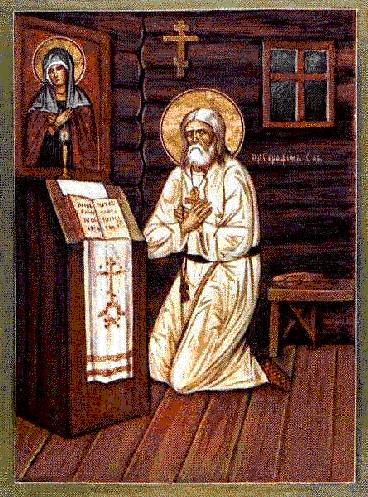St Seraphim of
Sarov
Memory celebrated January 2
 A
lifelong intimacy with God, and an abiding Christian love
for his fellow man, were two of the many attributes of a man
of Sarov, Russia, known as Seraphim, who attained sainthood
in the eighteenth century, a century in which far fewer
saints were selected than in the early centuries when being
a Christian meant risking one's life. A
lifelong intimacy with God, and an abiding Christian love
for his fellow man, were two of the many attributes of a man
of Sarov, Russia, known as Seraphim, who attained sainthood
in the eighteenth century, a century in which far fewer
saints were selected than in the early centuries when being
a Christian meant risking one's life.
A visionary of near divinity and a clergyman of rare
compassion, Seraphim's piety was such that he has been
linked with Sts. Theodosios and Sergios as the three
greatest saints born of Mother Russia. A native of Kursk,
Seraphim, who was baptised with the name of Prokhor in 1759,
was the son of a devout Christian woman named Agatha and a
hard-driving man named Isidore, a successful building
contractor. Seraphim's father met an untimely death while in
the process of erecting the Cathedral of Our Lady of Kursk,
leaving the widow and her ten-year-old son to see to the
completion of the church. The boy fell from a scaffolding
and recovered from what appeared to be fatal injuries, after
which he revealed that in a vision while he lay stricken the
Virgin Mary appeared to him with the message that he would
survive. This vision, the first of many intimacies with God
he was to experience thereafter, was the inspiration which
set him on his lifetime course of service to the Lord.
While yet a boy, Seraphim turned to the Holy Scriptures,
impressed particularly by the writings of Sts. Anthony and
Pachomios of Egypt, whose monasticism fascinated him, and,
after absorbing the teachings in the works of St. Basil, St.
Makarios, and St. John of the Ladder, he entered monastic
life at the age of eighteen. Tonsured a monk in 1786 and
given the name of Seraphim, he was ordained a priest in 1793
but chose not to preach until he had acquired a greater
proximity to God, which he thought could come only through
prayer and meditation in the complete solitude of the
wilderness. The forbidding forest was to be his home for the
next several years.
At one point, he broke off his sporadic contact with the
monastery and took up residence on a stone slab, on which he
is said to have remained for a thousand days and nights in
emulation of St. Symeon, removing himself from his
uncomfortable roost only for the bare essentials of life.
After this,test of spiritual and physical endurance, he
sought the comparative comfort of a hut, from which he would
emerge from time to time to tell of his visions, in which he
had the company of the apostles Peter and John and
occasionally the Virgin Mary.
Returning to the monastery, Seraphim had grown to such
spiritual stature that he was visited by countless pilgrims
seeking the way of the Lord, and was ultimately designated
as the spiritual father of the nuns of the Diveyev Convent,
an order which attested to his power of healing through
Jesus Christ and offered its prayers to him when he was
recognised as a prophet of the Lord and named a holy Starets
(Elder of the Faith). It was his firm belief that the
Kingdom of God was within us all and that only through the
Holy Spirit could come the joy of complete tranquility and
the inner peace which comes with faith. His sermons on this
particular theme brought the true meaning of God's love to
all those privileged to hear him.
Even the animals of the forest came to know the
friendship of the gentle Seraphim, and he would on frequent
occasions seek out the solitude of the wilderness, returning
to the monastery always with renewed faith and closeness to
nature that refreshed the spirit. Whenever he became ill, he
relied on his "joy," the Virgin Mary, to restore his health.
This association with the Divine was to manifest itself many
times over.
One of the most notable expressions of the power of
healing through Jesus and Mary came about when Seraphim was
called upon to help his friend, Nicholas Motovilov, a
wealthy benefactor who had been paralyzed by a stroke. The
prayers of Seraphim were answered and his friend was healed.
The true compassion of Seraphim was shown when he obtained
the release of three men who had looted his hut, which they
mistakenly thought to contain treasure. He died kneeling in
prayer in 1833, and seventy years later was made a
Saint.
from Orthodox Saints Vol 1, by Fr
George Poulos
Holy Cross Orthodox Press
|